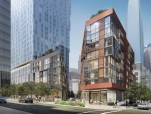Creative Class Tower

OMA architectural practice and Related California, a subsidiary of Related Companies, the country’s largest real estate company, have announced the completion of The Avery. The 56-story tower located four blocks from San Francisco Bay appeared a vivid landmark for the renewed Transbay area and the first high-rise project implemented by Rem Koolhaas’s Office for Metropolitan Architecture on the West Coast.
The city, named in honor of the Catholic Saint Francis of Assisi in 1776, is a popular tourist destination. It is known not only for its worldwide famous Golden Gate Bridge, cold summer fogs, the one before last century’s trams plying through its steep hills, but also an impressive combination of Victorian and modern architecture.
Recently, San Francisco is experiencing a new construction boom. Given the difficult terrain, the rather dense historical buildings spacing and the fact that the city is a square of 11 x 11 kilometers in plan (according to local laws, the expansion of these borders is not provided), it would seem that there is no place to be built there. Fortunately, the restriction on the construction of high-rise buildings no longer applies, which means that nothing limits the growth of the city upwards.
After Richard Florida’s book “Cities and the Creative Class”, published 15 years ago, the authorities of American cities were seized by the idea of reorganizing urban environment to meet the needs of the people of so-called creative professions. R. Florida argued that nowadays creative people make up almost a third of the total workforce in the United States and earn on average twice as much as workers and the service employees. Based on this theory, the creation of a dynamic and comfortable environment should attract the very same “creative class” - the key to the urban economy growth of the post-industrial times.
At the same time, ‘creativity’ is understood quite widely - it means not only belonging directly to the sphere of art, but also in general the ability to generate ideas. The development model of a creative city is based on three “T” - technology, talent and tolerance, which will provide the city with an impetus for further development. And according to many experts, San Francisco is the undisputed leader in these realms.
Full content of this issue you can read here
The full version of the article can be read in our printed issue, also you can subscribe to the web-version of the magazine
 Materials provided by OMA NY
Materials provided by OMA NY


